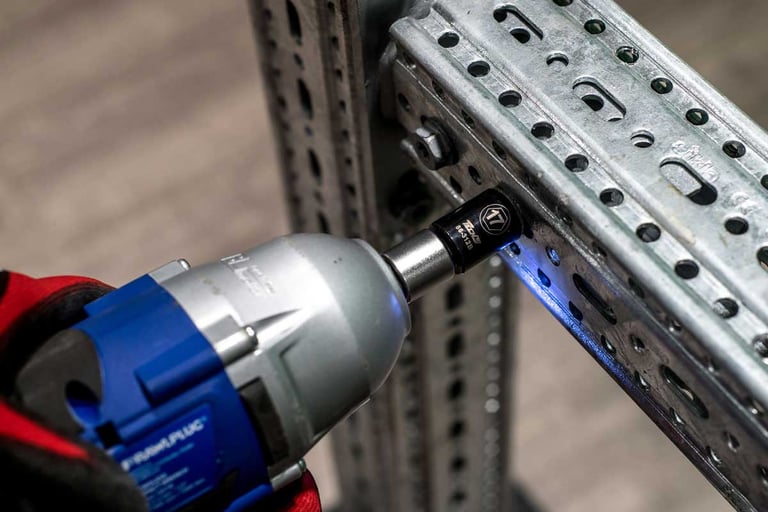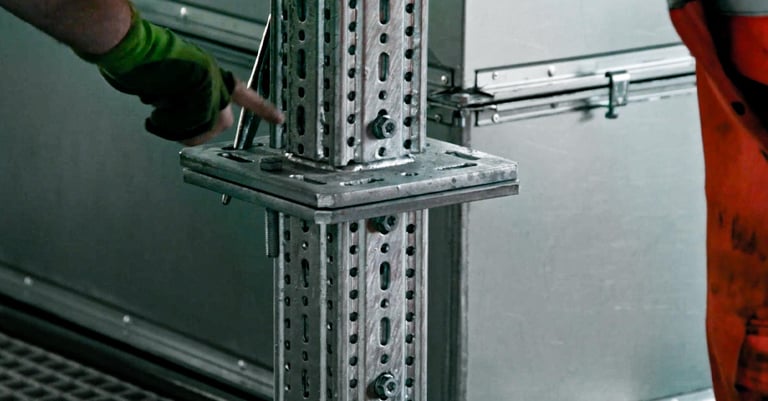Sikla Framo has grown, and continues to grow, in popularity recently in the M&E sector, and not for no reason.
It's a highly innovative and efficient modular steel system that comes with many bonuses. But you may wonder, why is it so favoured? What makes it so great? Surely it has its cons, too, right? Well, that's what this article is intended to clear up. You can navigate through the following subheadings:
What is Sikla Framo secondary modular steelwork?
Sikla Framo, shortened to siFramo, is a non-welded modular steel support system made of a compact, off-the-shelf readily available range of components, connected with a single type of screw. It is used for constructing supports, frames, and load-bearing structures. Framo can support loads that are beyond the capabilities of strut type channels and would traditionally require off-site fabricated steelwork and heavy steel sections.
What is the history of secondary modular steelwork?
In 2006, Sikla launched the first generation of the ‘siFramo’ system. It was a pioneer for the industry, being the first 3-dimensional steel framing system that didn’t require hot-works and was the only technically acceptable alternative to welded secondary steel (PFCs, box-sections, I-beams). It was and still is often used to support pipework and cable containment beyond the load capacity of channel.
Framo was developed based on this key specification:
-
Connection between frame members must be possible anywhere and on all four sides
-
No member clashes that a welded frame would similarly not cause
The initial goal of the system was to avoid hot works, and that remains one of its primary assets.

Where has the demand for Sikla Framo come from?
There is a lot that can be done with welded steel and this article is not dismissing that by any means. But now, especially after COVID19, contractors have been taught the hard way to focus not only on cost savings, but also on better, quicker, and more efficient methods of doing things. Offsite manufacturing is driving this, with Framo being at the forefront of it.
Offsite construction is becoming the go-to option for many contractors and projects, being referred to as ‘the industry’s future’, and for good reason. Ultimately, the biggest benefits are cost-saving and reduced health & safety risks, but there are many. Its success rate is much higher than onsite construction, thanks to the design process’s demand for compliance. There is also reduced labour, reduced number of deliveries, timely deliveries, and of course, reduced carbon footprint. Sustainability in itself is a substantial advantage, especially when you consider how much damage construction has done to the environment over the years. Knowing that that doesn’t have to be the case moving forward gives a glimmer of hope. And with the Net Zero target for 2050 and carbon being a major concern, this is even more important. Sikla Framo makes this effortless with its many benefits...

What are the advantages of Sikla Framo?
-
Highly flexible with unlimited connection points: With thread-forming bolts and an ordinary impact wrench, secure and adjustable connections to the section can be created at any point and in any direction.
-
Adjustable: elongated holes in the connecting brackets allow for up to 10mm adjustment at each connection point without needing to move the brackets to the next hole.
-
Inter-connectable: Framo connects with primary steelwork for securing supports to the building structure and also connects with strut channels for an integrated support solution, so it can be used to improve/strengthen existing structures.
-
Lightweight: Framo is up to 50% lighter than its traditional heavy steel counterparts. This makes installation, transport, and the general process much easier.
-
Minimal installation time: Especially when compared to traditional steel supports, modular steel reduces installation time significantly. In fact, if you need something built tomorrow, it can easily be done, as there is no need for any welding, jigging, finishing, etc. Additionally, the aforementioned advantages of adjustability and light weight make for a shorter installation time.
-
Corrosion-protected: Framo is fully hot-dip galvanized with superior corrosion resistance for external use and demanding environment, straight from the box. The same can’t be said for traditional steel (which you would have to galvanize). When cut, the cut ends are also protected by cathodic protection.
-
Reduced labour + required skills: Because of the ease of installation of modular steel systems, it accounts for less labour and can be done with less-skilled workers, whereas welding requires highly skilled workers.
-
Sustainable: There is no need for hot-works, meaning less environmental damage. Also, thanks to its modular and lightweight design, deliveries are less frequent, reducing CO2 emissions.
-
Surface: Framo can be connected to just about any surface; including concrete, steel, non-penetrative roof supports, and more.
-
Cost-effective: While raw material of box-section, for example, is far cheaper to buy initially, you need to take into account the cost of welding, jigging, and material-handling. You might also have to put holes in it, connect pipe clips, and/or weld strut to it for the frame to work. You must also consider the environment – if it’s outdoors, it will likely need to be hot-dip galvanized. This adds up costs, for both the finish, as well as the cost of transit from where it’s fabricated to the galvanizer. On top of that, there’s the cost of labour, broaching tools, mac drills, and more. Suffice it to say that in the end, you’d be saving more money with Framo.
-
Tested: Last but not least, using Framo gives peace of mind because all of the components are individually tested with data and you know what you’re working with. With traditional steel, sometimes the source is unknown and can be of cheaper quality.

What are the disadvantages/misconceptions of Sikla Framo?
Despite their convenience and great performance, Framo might not be the best option for each application.
-
Not well-recognised: Because Framo isn’t as readily available, known, and used as traditional steel, some M&E contractors still are told not to include modular steel when submitting a tender for a project. This could either be because they believe that cost will be the primary factor for winning the tender, because installers onsite are more familiar with traditional steel, or because they believe that channel section is suited for all supports.
-
Upfront costs: As mentioned, Framo will always be more expensive to buy compared to raw material of other steel profiles, and this may be off-putting to some. However, in the long-run, you’re not actually saving money due to the cheaper installation process, so Framo being seen as more expensive is actually a common misconception.
-
Workarounds: Even though the system works in most applications, in other cases, you have to work with it. Traditional steel can be welded together virtually anywhere; wherever you need it. But with Framo, you may have to come up with a workaround e.g. splitting a beam, which means it may take longer to complete the design. However, in the grand scheme of things, you are still saving time.
-
Connection components: To connect one section of Framo to another, you need connection/interfacing components. When there is limited space between services, e.g. between pipework and cables, it can be quite difficult to fit the Framo as well as the connection components, or to even find one that is small enough off the shelf.
-
In specific cases where you have a particularly heavy load (past a certain point), you may not be able to use Framo and would be required to use traditional steel. This is very rare, though.
-
Framo is only available in certain thicknesses, so by default, you could be overengineering. Whereas with traditional steel, you can use any thickness you want and optimise it to the design’s needs.
Conclusion
All in all, whether or not Framo is suitable for you self-evidently depends on the requirements of each specific project. It’s clear that the cost-saving, labour-saving, environmental, and other advantages of Framo, outweigh the downsides. It may not work for every application. However, in most cases, Framo is not only applicable, but it performs exceptionally, and that’s what makes it such a comprehensive and efficient innovation.


